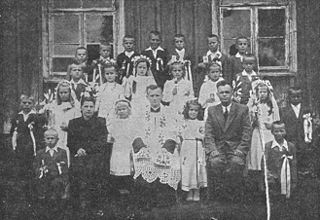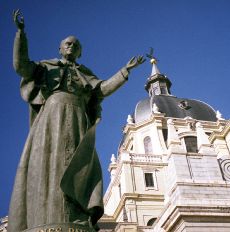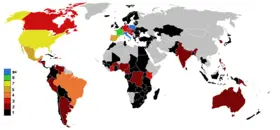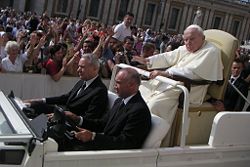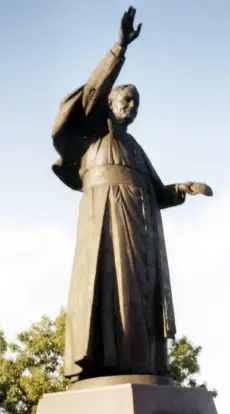| John Paul II | |
|---|---|
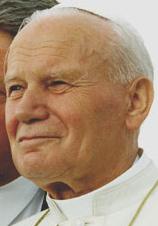
| |
| Birth name | Karol Józef Wojtyła |
| Papacy began | October 16, 1978 |
| Papacy ended | April 2, 2005 |
| Predecessor | John Paul I |
| Successor | Benedict XVI |
| Born | 1920 May 18 Wadowice, Poland |
| Died | 2005 April 2 Apostolic Palace, Vatican City |
| Other popes named John Paul | |
Pope John Paul II, born Karol Józef Wojtyła (May 18, 1920 – April 2, 2005), reigned as the two-hundred-and-sixty-fourth Pope of the Roman Catholic Church from October 16, 1978, until his death more than 26 years later, making his the second-longest pontificate in modern times after Pius IX's 31-year reign. He is the only Polish pope, and was the first non-Italian pope since the Dutch Adrian VI in the 1520s.
His early reign was marked by his opposition to Communism, and he is often credited as one of the forces contributing to its collapse in Eastern Europe. In the later part of his pontificate, he was notable for speaking against war, fascism, dictatorship, materialism, abortion, contraception, relativism, unrestrained capitalism, and what he deemed the "culture of death."
John Paul II was pope during a period in which Catholicism's influence declined in developed countries but expanded in the Third World. During his reign, he traveled extensively, visiting over 100 countries, more than any of his predecessors. He remains one of the most-traveled world leaders in history. He was fluent in numerous languages. As part of his special emphasis on the universal call to holiness, he canonized a great number of people.
In 1992, he was diagnosed with Parkinson's disease but remained active for several years. The last years of his reign were marked by concern as to leadership should he become severely incapacitated and speculation as to whether he should abdicate. In February 2004, John Paul II was nominated for a Nobel Peace Prize honoring his life's work in opposing Communist oppression and helping to reshape the world. He died on April 2, 2005 after a long fight against Parkinson's disease and other illnesses.
Immediately after his death, many of his followers called for his elevation to sainthood as soon as possible. Both L'Osservatore Romano and Pope Benedict XVI, John Paul's successor, referred to John Paul II as "the Great."
| Styles of Pope John Paul II | |

| |
| Reference style | His Holiness |
| Spoken style | Your Holiness |
| Religious style | Holy Father |
| Posthumous style | Servant of God |
Biography
Early life
Karol Józef Wojtyła was born on May 18, 1920 in Wadowice in southern Poland, and was the youngest of three children of Karol Wojtyła and Emilia Kaczorowska. His mother died in 1929 when he was just nine years old and his father supported him so that he could study. His brother, who worked as a doctor, died when Karol was 12. His youth was marked by extensive contacts with the then-thriving Jewish community of Wadowice. He practiced sports during his youth and was particularly interested in football (soccer).
After completing his studies in 1938 at the Marcin Wadowita high school in Wadowice, Karol enrolled at the Jagiellonian University in Kraków, and in a school for drama. He worked as a volunteer librarian and did compulsory military training in the Academic Legion, but refused to hold or fire a weapon. In his youth he was an athlete, actor, and playwright, and he learned as many as 10 languages during his lifetime, including Latin, Ukrainian, Greek, Spanish, Portuguese, French, Italian, German, and English, other than his native Polish. He also had some facility with Russian.
In 1939, Nazi occupation forces closed the Jagiellonian University; its academics were arrested and the university was suppressed throughout the Second World War. All able-bodied males had to have a job. From 1940 to 1944, Karol worked as a messenger for a restaurant, a manual laborer in a limestone quarry, and then as a salesman for the Solvay chemical factory to earn his living and to avoid being deported to Germany. His father also died in 1941, when Karol was 20.
Church career
In 1942, Wojtyła entered the underground seminary run by the Archbishop of Kraków, Cardinal Adam Stefan Sapieha. Wojtyła was ordained a priest on November 1, 1946, by Cardinal Sapieha. Not long after, he was sent to study theology at the Pontifical University of Saint Thomas Aquinas in Rome, commonly known as the Angelicum, where he earned a licentiate and later a doctorate in sacred theology. This doctorate, the first of two, was based on the Latin dissertation Doctrina de fide apud S. Ioannem a Cruce (The Doctrine of Faith According to Saint John of the Cross). Even though his doctoral work was unanimously approved in June 1948, he was denied the degree because he could not afford to print the text of his dissertation (an Angelicum rule). In December of that year, a revised text of his dissertation was approved by the theological faculty of Jagiellonian University in Kraków and Wojtyła was finally awarded the degree.
He earned a second doctorate, based on an evaluation of the possibility of founding a Catholic ethic on the ethical system of phenomenologist Max Scheler (An Evaluation of the Possibility of Constructing Christian Ethics on the Basis of the System of Max Scheler), in 1954. As was the case with the first degree, he was not granted the degree upon earning it. This time, the faculty at Jagiellonian University was forbidden by Communist authorities from granting the degree. In conjunction with his habilitation at Catholic University of Lublin, Poland, he finally obtained the doctorate of philosophy in 1957 from that institution, where he had assumed the chair of the Department of Ethics in 1956.
On July 4, 1958, Pope Pius XII named him titular bishop of Ombi and auxiliary to Archbishop Baziak, apostolic administrator of the Archdiocese of Kraków. He was consecrated as bishop on September 28, 1958, making him, at 38, the youngest bishop in Poland.
In 1962, Bishop Wojtyła took part in the Second Vatican Council, and in December 1963 Pope Paul VI appointed him Archbishop of Kraków. On June 26, 1967, Paul VI announced Wojtyła's promotion to the Sacred College of Cardinals with the title of Cardinal Priest of San Cesareo in Palatio.
A Pope from Poland
In August 1978, following Paul's death, he voted in the Papal Conclave that elected Pope John Paul I, who at 65 was considered young by papal standards. However, John Paul I was in poor health and he died after only 33 days as pope, thereby precipitating another conclave.
Voting in the second conclave was divided between two particularly strong candidates: Giuseppe Siri, the Archbishop of Genoa; and Giovanni Benelli, the Archbishop of Florence and a close associate of Pope John Paul I. In early ballots, Benelli came within nine votes of victory. However, Wojtyła secured election as a compromise candidate, in part through the support of Franz Cardinal König and others who had previously supported Cardinal Siri.
He became the two-hundred-and-sixty-fourth Pope, according to the chronological List of popes. At only 58 years-of-age, he was the youngest pope elected since Pope Pius IX in 1846. Like his immediate predecessor, Pope John Paul II dispensed with the traditional Papal coronation and instead received ecclesiastical investiture with the simplified Papal inauguration on October 22, 1978. During his inauguration, when the cardinals knelt before him, and took their vows and kissed his ring, he stood up as the Polish primate Stefan Cardinal Wyszynski knelt down, and he stopped him from kissing the ring and hugged him. As Bishop of Rome he took possession of his Cathedral Church, the Basilica of St. John Lateran, on November 12, 1978.
John Paul began his papacy when the Soviets controlled his native country of Poland, as well as the rest of Eastern Europe. He was a harsh critic of Communism, and has been credited with helping to bring down Communism in eastern Europe by sparking what amounted to a peaceful revolution in his Polish homeland.
The Pope’s epic June 1979 pilgrimage to his homeland on the nine-hundredth anniversary of the martyrdom of Saint Stanislaus of Krakow—made in spite of the resistance of the Polish Communist regime—were nine days in which the history of the twentieth century pivoted. In 40-some sermons, addresses, lectures, and impromptu remarks, the Pope reminded his fellow Poles of their historical Christian heritage and encouraged them in their showdown with the Communist regime. On June 2, 1979, in his historic homily at Victory Square in Warsaw, John Paul II said: "It is not possible to understand the history of the Polish nation without Christ." John Paul's visit created a revolution of conscience that, 14 months later, produced the Solidarity movement.
On January 15, 1981, John Paul II received in audience a delegation headed by Lech Walesa, head of the anti-Communist Polish labor movement that eventually brought democracy to Poland and sparked the downfall of Communism in eastern Europe. Walesa credited John Paul with giving Poles the courage to rise up. "The pope started this chain of events that led to the end of Communism," Walesa said. The pope made additional trips to Poland in 1983 and 1987. British historian Timothy Garton Ash noted, "Without the Pope, no Solidarity. Without Solidarity, no Gorbachev. Without Gorbachev, no fall of Communism."
Assassination attempt
On May 13, 1981, John Paul II was shot and critically wounded by Mehmet Ali Ağca, a Turkish gunman, as he entered St. Peter's Square to address an audience. He was rushed into the Vatican complex, then to the Gemelli Hospital, where Dr. Francesco Crucitti, a noted surgeon, had just arrived by police escort after hearing of the incident. En route to the hospital, he lost consciousness. The pope had lost almost three-quarters of his blood. He underwent five hours of surgery to treat his massive blood loss and abdominal wounds.
Ağca was caught and restrained by a nun until police arrived. He was sentenced to life imprisonment. Two days after Christmas 1983, John Paul II visited the prison where his would-be assassin was being held. The two spoke privately for 20 minutes. John Paul II said, "What we talked about will have to remain a secret between him and me. I spoke to him as a brother whom I have pardoned and who has my complete trust." The pope also stated that Our Lady of Fatima helped keep him alive throughout his ordeal.
On March 2, 2006, an Italian parliamentary commission concluded that the Soviet Union, through its KGB intelligence service, was behind the attempt, in retaliation for John Paul II's support of Solidarity, the pro-democratic Catholic Polish workers' movement. The report alleged that certain Communist Bulgarian security departments were utilized to prevent the Soviet Union's role from being uncovered. [1]
The Pope for youth
John Paul II had a special relationship also with Catholic youth and is known by some as "The Pope for Youth." Before he was pope, he used to camp and mountain hike with the youth. He still went mountain hiking when he was pope. He was a hero to many of them. Indeed, at gatherings, young Catholics, and conceivably non-Catholics, were often fond of chanting the phrase "JP Two, We Love You," and occasionally John Paul would reply "JP Two, He Loves YOU!" He was particularly concerned with the education of young future priests, and made many early visits to Roman seminaries, including the Venerable English College in 1979.
He established World Youth Day in 1984, with the intention of bringing young Catholics from all parts of the world together to celebrate their faith. These week-long meetings of youth occur every two or three years, attracting hundreds of thousands of young people, who go there to sing, party, have a good time, and deepen their faith. Some of his most faithful youths gathered themselves in two organizations: "papaboys" and "papagirls."
Other accomplishments
In 1989, the Pontiff arranged the first meeting ever between a Pope and Kremlin officials, meeting Gorbachev in the Vatican. They announced that the Vatican and Moscow would establish diplomatic ties. Gorbachev himself acknowledged the role of John Paul II in the fall of Communism, saying, "What has happened in eastern Europe in recent years would not have been possible without the presence of this pope." (quoted in La Stampa, March 3, 1992)
John Paul II emphasized what he called the "universal call to holiness" and attempted to define the Roman Catholic Church's role in the modern world. He spoke out against ideologies and politics of Marxism-Leninism, socialism, imperialism, hedonism, relativism, materialism, fascism, Nazism, racism, and unrestrained capitalism. He also fought against oppression, secularism, and poverty. Although he was on friendly terms with many Western heads of state and leading citizens, he criticized what he believed to be the corrosive spiritual effects of modern Western consumerism and the concomitant widespread secular and hedonistic orientation of Western populations.
John Paul II also affirmed traditional Roman Catholic teachings against abortion and contraception, and pioneered the Church's stance on matters such as embryonic stem cell research, human cloning, in vitro fertilization, euthanasia, evolution, interfaith matters, and unjust wars. He also defended traditional teachings on marriage and gender roles by opposing divorce, same-sex marriage, and the ordination of women. He called upon followers to vote according to Catholic teachings.
John Paul II became known as the "Pilgrim Pope" for traveling greater distances than had all his predecessors combined. His extensive travels brought him into contact with believers from many divergent faiths. He constantly attempted to find common ground, both doctrinal and dogmatic. At the World Day of Prayer for Peace, held in Assisi on October 27, 1986, more than 120 representatives of different religions and Christian denominations, including John Paul II, spent a day together with fasting and praying.
He beatified 1,340 people, more people than any previous pope. The Vatican reported that he canonized more people than the combined tally of his predecessors during the last five centuries, and from a far greater variety of cultures.[2]
Health
When he became pope in 1978, John Paul II was an avid sportsman, enjoying hiking and swimming. In addition, he traveled extensively after becoming pope.
John Paul's obvious physical fitness and athletic good looks earned much comment in the media following his election, which compared his health and trim figure to the poor health of John Paul I and Paul VI, the portliness of John XXIII and the constant claims of ailments of Pius XII. An Irish Independent article in the 1980s labeled John Paul the "the keep-fit pope."
Although the 1981 assassination attempt dealt the pope's health a major blow, he went on to a full recovery, and continued to demonstrate an impressive physical condition throughout the 1980s.
Starting about 1992, John Paul II's health slowly declined. He began to suffer from an increasingly slurred speech and difficulty in hearing. Though not officially confirmed by the Vatican until 2003, most experts agreed that the now frail pontiff suffered from Parkinson's disease. The contrast between the athletic John Paul of the 1970s and the declining John Paul of later years was striking.
In February 2005, John Paul II was taken to the Gemelli hospital with inflammation and spasm of the larynx, the result of influenza. Though later released from the hospital, he was taken back after a few days because of difficulty breathing. A tracheotomy was performed, which improved the Pope's breathing but limited his speaking abilities, to his visible frustration. In March 2005, speculation was high that the Pope was near death; this was confirmed by the Vatican a few days before John Paul II died.
Death

On March 31, 2005, the Pope developed a very high fever and profoundly low blood pressure, but was neither rushed to the hospital nor offered life support. Instead, he was offered medical monitoring by a team of consultants at his private residence. This was taken as an indication that the pope and those close to him believed that he was nearing death; it would have been in accordance with his wishes to die in the Vatican. Later that day, Vatican sources announced that John Paul II had been given the Anointing of the Sick by his friend and secretary Stanisław Dziwisz. During the final days of the pope's life, the lights were kept burning through the night where he lay in the Papal apartment on the top floor of the Apostolic Palace.
Tens of thousands of people rushed to the Vatican, filling St. Peter's Square and beyond with a vast multitude, and held vigil for two days.
On Saturday, April 2, at about 3:30 p.m. CEST, John Paul II spoke his final words, "Let me go to the house of the Father," to his aides in his native Polish and fell into a coma about four hours later. He died in his private apartment at 9:37 p.m., 46 days short of his eighty-fifth birthday. A crowd of over two million within Vatican City, over one billion Catholics world-wide, and many non-Catholics mourned John Paul II.
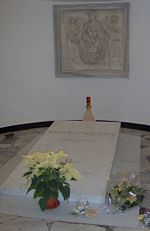
The public viewing of his body in St. Peter's Basilica drew over four million people to Vatican City and was one of the largest pilgrimages in the history of Christianity. Many world leaders expressed their condolences and ordered flags in their countries lowered to half-mast. Numerous countries with a Catholic majority, and even some with only a small Catholic population, declared mourning for John Paul II. The nation of Poland was particularly affected by his death.
On April 8, the Mass of Requiem was conducted by the Dean of the College of Cardinals, Joseph Ratzinger, who would become the next pope under the name of Benedict XVI. It has been estimated to have been the largest attended funeral of all time.
The funeral of Pope John Paul II saw the single largest gathering of heads of state in history, who had come together to pay their respects. In his memory, a number of Catholic schools have named their houses after him.
Teachings
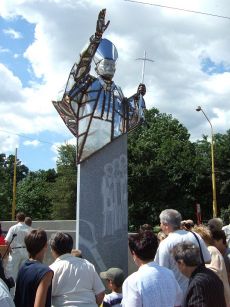
As pope, one of John Paul II's most important roles was to teach people about Christianity. He wrote 14 papal encyclicals (List of Encyclicals of Pope John Paul II) that many observers believe will have long-lasting influence on the church. These include: his Apostolic Letter At the beginning of the third millennium, where he emphasized the importance of "starting afresh from Christ;" The Splendor of the Truth, where he stressed the dependence of man on God and his law; and On the Relationship between Faith and Reason, in which he promoted a renewed interest in philosophy and an autonomous pursuit for truth in theological matters.
John Paul II also wrote extensively about workers and the social doctrine of the Church, which he discussed in three encyclicals. John Paul also stressed the dignity of women and the importance of the family for the future of mankind.
John Paul affirmed the teachings of Vatican II and did much to implement them. Nevertheless, his critics often wished aloud that he would embrace the so-called "progressive" agenda that some hoped would evolve as a result of the Council. John Paul II continued to declare that contraception, abortion, and homosexual acts were gravely sinful, and, with Cardinal Ratzinger (future Pope Benedict XVI), opposed Liberation theology.
In 1994, he officially declared the Church's lack of authority to ordain women to the priesthood. In addition, John Paul II chose not to end the discipline of mandatory priestly celibacy, although in a small number of unusual circumstances, he did allow married clergymen of other Christian traditions who later became Catholic to be ordained as priests.
Legacy
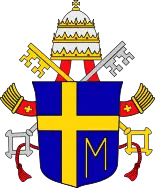
Since giving his homily at the funeral of Pope John Paul, Pope Benedict XVI has continued to refer to John Paul II as "the Great." At the 2005 World Youth Day in Germany, Benedict, speaking in Polish, said, "As the great Pope John Paul II would say: keep the flame of faith alive in your lives and your people." In May 2006, Benedict visited John Paul's native Poland. During that visit he repeatedly made references to "the great John Paul" and "my great predecessor." In addition to the Vatican calling him "the great," numerous newspapers have also done so. For example the Italian newspaper Corriere della Sera called him "the Greatest" and the South African Catholic newspaper, The Southern Cross, has called him "John Paul II The Great."
Scholars of Canon Law say that there is no official process for declaring a pope "Great." The title establishes itself through popular, and continued usage. The three popes who today commonly are known as "Great" are Leo I, who reigned from 440–461 and persuaded Attila the Hun to withdraw from Rome, thus saving Christianity and Catholicism in Europe from destruction; Gregory I, 590–604, after whom the Gregorian Chant is named; and Nicholas I, 858–867, who also withstood a siege of Rome (in this case from Carolingian Christians, over a dispute regarding marriage annulment).
Canonization process
On May 9, 2005, Benedict XVI began the beatification process for his predecessor, John Paul II. Normally five years must pass after a person's death before the beatification process can begin. The decision was announced on May 13 of that year at the Feast of Our Lady of Fatima and the twenty-fourth anniversary of the assassination attempt on John Paul II at St. Peter's Square.
In early 2006, it was reported that the Vatican was investigating a possible miracle associated with John Paul II. A French nun, confined to her bed by Parkinson's Disease, is reported to have experienced a "complete and lasting cure after members of her community prayed for the intercession of Pope John Paul II." [3]
On May 28, 2006, during a Mass before an estimated 900,000 people in John Paul II's native Poland, Pope Benedict XVI encouraged prayers for the early canonization of John Paul II and stated that he hoped canonization would happen "in the near future."
On March 8, 2007, the Vicariate of Rome announced that the diocesan phase of John Paul's cause for beatification is at an end. Following a ceremony on April 2, 2007—the second anniversary of the Pontiff's death—the cause proceeded to the scrutiny of the committee of lay, clerical, and episcopal members of the Vatican's Congregation for the Causes of Saints, who will conduct an investigation of their own.
Notes
- ↑ Italian Panel: Soviets Behind Pope Attack. breitbart.com. Retrieved December 11, 2007.
- ↑ The Vatican News, Saints. www.vatican.va. Retrieved December 11, 2007.
- ↑ Vatican may have found Pope John Paul's 'miracle' ABC News online. Retrieved December 11, 2007.
ReferencesISBN links support NWE through referral fees
- Buttiglione, Rocco. Karol Wojtyla: The Thought of the Man Who Became Pope John Paul II. Wm. B. Eerdmans Publishing, 1997. ISBN 9780802838483
- O'Connor, Gary. Universal Father. Bloomsbury Publishing, 2005. ISBN 1596910968
- Paul II, John. Memory and Identity - Conversations at the Dawn of a Millennium. Rizzoli, 2005. ISBN 0847827615
- Paul II, John. Theology of the Body: Human Love In The Divine Plan. Pauline Books and Media, 1997. ISBN 0819873942
- Simpson, Peter. On Karol Wojtyła. Wadsworth Publishing, 2000. ISBN 053458375X
- Weigel, George. Witness to Hope. HarperCollins, 1999. ISBN 006018793X
- Wojtyła, Karol. Love and Responsibility. Ignatius Press, 1993. ISBN 0898704456
External links
All links retrieved January 30, 2025.
- The Holy See - The Holy Father - John Paul II – www.vatican.va.
- Link to collected tributes, writings and commentary on John Paul II – www.ratzingerfanclub.com.
- Ascension of John Paul the Great. – www.ascension-research.org.
| Preceded by: The Peacemakers: Nelson Mandela, F.W. de Klerk, Yasser Arafat and Yitzhak Rabin |
Time's Man of the Year 1994 |
Succeeded by: Newt Gingrich |
| Papal succession Born: 18 May 1920; | ||
|---|---|---|
| Religious titles | ||
| Preceded by: Eugeniusz Baziak |
Archbishop of Kraków 1963–1978 |
Succeeded by: Franciszek Macharski |
| Preceded by: Pope John Paul I |
Pope 1978–2005 |
Succeeded by: Pope Benedict XVI |
| |||||||||||||
Credits
New World Encyclopedia writers and editors rewrote and completed the Wikipedia article in accordance with New World Encyclopedia standards. This article abides by terms of the Creative Commons CC-by-sa 3.0 License (CC-by-sa), which may be used and disseminated with proper attribution. Credit is due under the terms of this license that can reference both the New World Encyclopedia contributors and the selfless volunteer contributors of the Wikimedia Foundation. To cite this article click here for a list of acceptable citing formats.The history of earlier contributions by wikipedians is accessible to researchers here:
The history of this article since it was imported to New World Encyclopedia:
Note: Some restrictions may apply to use of individual images which are separately licensed.
